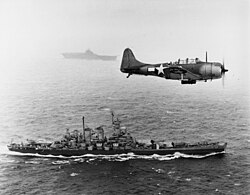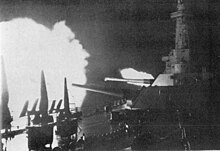USS Washington (BB-56)
|
USS Washington in 1943 with an SBD Dauntless
|
||||||||||||||||||||||
|
||||||||||||||||||||||
|
||||||||||||||||||||||
|
||||||||||||||||||||||
|
||||||||||||||||||||||
|
||||||||||||||||||||||
The USS Washington (BB-56) was a battleship of the United States Navy and the second ship of the North Carolina class . Together with her sister ship North Carolina , she was used in World War II .
Development history
The ten-year construction freeze for capital ships agreed at the Washington Fleet Conference of 1922 led to a 14-year break in US battleship construction (since West Virginia was commissioned in 1923). Nevertheless, numerous designs for new capital ships were commissioned and created during this period. The London Naval Agreements of 1930 and 1936 , however, further limited the considerations. For example, the standard displacement was not allowed to exceed 35,000 ts, and a limitation of the caliber of the main armament to 35.6 cm was targeted. However, the latter could not be contractually agreed due to resistance from France and Japan and remained a recommendation. Based on these specifications, the design work was started in May 1935, as the agreed construction break was to end at the beginning of 1937. Although the almost finished design was already available in October 1936, the construction contract for two units was not issued until August 1, 1937. The reason for this was the refusal of the American government to be the first nation to resume battleship construction. It was therefore decreed that construction work could only begin when other states laid capital ships of comparable tonnage on keel. The armament of the North Carolina class with 406 mm guns is due to a change in caliber, which took place after the start of construction of the type ship .
draft
North Carolina and Washington were the first US Navy battleships to be constructed in longitudinal frame construction. This development led to an unusual shape of the stern, in which the two inner drive shafts were housed in a specially shaped part of the hull, called the “ pickaxe ”. The design allowed the use of twin rudders, which resulted in good maneuverability in a small turning circle. In return, however, the hull was considered to be quite cramped overall, which was not least due to the contractual specifications. The use of longitudinal ribs enabled the construction of special underwater protection: three longitudinal bulkheads were drawn in on each side of the ship, the innermost of which was designed as a torpedo bulkhead with thicker armor. In addition to the six inner bulkheads, two further outer bulkheads were installed, which, together with a torpedo bulge, completed the protection system. The propulsion system, consisting of four turbine sets, worked on the high pressure hot steam principle and was thus also an innovation in battleship construction in the United States. The four engine rooms, each containing two boilers and one turbine set, were arranged one behind the other and each responsible for driving a shaft.
406 mm guns were introduced as early as 1921 for the Maryland , but a more modern and at the same time lighter model was used for the North Carolina class, which could fire heavier shells thanks to a larger barrel elevation over a longer distance. North Carolina and Washington were also the first battleships of the American Navy, which were designed for the installation of 127-mm multi-purpose guns L / 38 including the associated fire control systems. This principle was continued for all further battleship construction up to the Iowa and the planned Montana class . The North Carolina- class ships were the first US capital ships to dispense with torpedo armament and to be put into service equipped with on-board aircraft .
Modifications
The most important changes to the North Carolina -class ships concerned the equipment with radar and additional or improved air defense systems . The radar-based air surveillance system of the type CXAM was installed as early as the beginning of 1942, followed later by fire control radar for heavy and medium artillery as well as the SG radar for surveillance of the sea area. In the fall of 1942, eight additional 28-mm Fla-MKs were installed in two quadruple mounts on the Washington , before the entire 28-mm equipment was replaced in the fall by initially ten and later fifteen 40-mm quadruple mounts. Up to June 1942 there were 28 tubes on 127 mm anti-aircraft machine guns, which had been supplemented by twenty Oerlikon automatic cannons in April . The 20 mm armament doubled to forty single mounts by autumn 1942 . In April 1943, the Washington owned a total of 64 single and twin 20mm MKs after all 127mm equipment had been dismantled at the end of the previous year. At the time of the Japanese surrender, the Washington carried a total of 83 20 mm guns in eight double, 63 single and one quadruple mounts in addition to the fifteen 40 mm quadruples, which were added in April 1944.
commitment
The Washington formed in March 1942 with the aircraft carrier Wasp , the heavy cruisers Tuscaloosa and Wichita and eight destroyers , the Task Force 39, in the Battle of the Atlantic, the British Fleet Home should support. On the crossing to Scapa Flow, the commander of TF 39, Rear Admiral John Wilcox , went overboard under circumstances that have not yet been clarified.
The tasks of the task force included remote security against an outbreak of the Tirpitz from Norway and the release of British units that were urgently needed in other theaters of war such as the Indian Ocean. From April to June, Washington was involved in securing convoys of Northern Sea convoys before returning to the United States in July 1942. After being in a shipyard in New York, she was relocated through the Panama Canal to the Pacific in August and arrived in Tonga in September . In the course of the Battle of the Solomon Islands, she joined the TF 17, with which she covered the supplies for the landing forces on Guadalcanal against Japanese attacks. This mission culminated in the naval battle of Cape Esperance on October 11 and 12, 1942. At the end of October, the Washington , now part of TF 64, only barely escaped a torpedo from the Japanese submarine I-15 .
The TF 64, which also included the battleship South Dakota and some destroyers, hit on 14/15. November 1942 on the Japanese 2nd Fleet during the Battle of Guadalcanal . In the ensuing battle, three American destroyers were sunk and the South Dakota was so badly damaged that all of its on-board electronics and thus its radar failed. The practically defenseless ship came under concentrated fire from the battle cruiser Kirishima and two heavy cruisers. Washington , until then undiscovered by the Japanese, caught up in the dark and fired several accurate - since radar-guided - salvos at short range with which it destroyed the Kirishima .
The Washington then served with the TF 11 and TF 16 in the Solomon Islands until April, before moving to Pearl Harbor for overhaul in May . After training missions with aircraft carriers in the New Hebrides , the Washington , again together with the South Dakota and now organized in Task Group (TG) 50.1, participated in the landings on the Gilbert Islands in November 1943.
At the turn of 1943/44, it formed part of the TG 58.1 with the Massachusetts and Indiana , which launched the January / February attacks on the Maleolap and Kwajalein tolls to support the landings on the Marshall Islands . It came to a collision of the Washington with the Indiana . The former was only able to return to the Pacific theater of war at the end of May after emergency repairs on the Majuro Atoll and in Pearl Harbor as well as a final repair in Bremerton .
In June 1944, the Washington covered air strikes on the Mariana Islands and the Vulcan Islands . She was also involved in the subsequent battle in the Philippine Sea . This was followed by coastal fire tasks in the course of the landings on Peleliu and renewed cover for air strikes, this time on the Philippines. In October, Washington belonged to TG 38.3, whose task it was to take out the Japanese air forces on Okinawa , Luzon , Formosa and Mindoro . This mission lasted until the end of January 1945, before the Washington secured TG 58.4 during attacks on mainland Japan in February to support the landing on Iwo-Jima . She also took part in the shelling of this island with her sister ship North Carolina before returning to TF 58.
April 8, 1945, which supported Washington nor the landings on Okinawa before she took early June the march back to the USA to complete a dockyard period, which lasted until after the war. Relocated back to the Atlantic, she made a Magic Carpet trip to Great Britain before being decommissioned and hung up on June 27, 1947. On June 1, 1960, it was deleted from the fleet list, and the ship was finally sold on May 24, 1961 for scrapping in Newark.
literature
- Ivan Musicant: Battleship at War: The Epic Story of the USS Washington. Houghton Mifflin Harcourt 1986, ISBN 978-0151104000 .
Web links
- History of Washington in the Dictionary of American Naval Fighting Ships (English)
- Pictures of the Washington at navsource.org (engl.)
- USS Washington: Historic World War II Battleship (Engl.)



